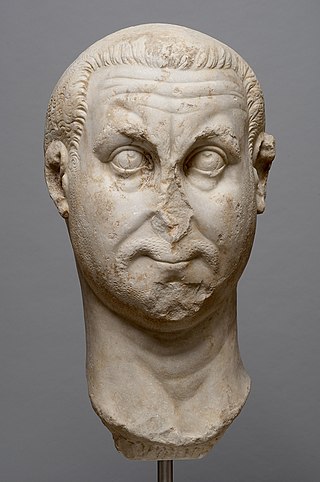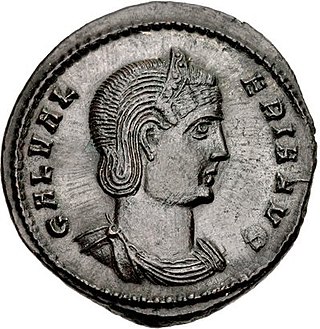Saints Narcissus, Argeus and Marcellinus | |
|---|---|
| Martyrs | |
| Died | ~320 AD Tomi |
| Venerated in | Roman Catholic Church |
| Feast | January 2 |
Saints Narcissus, Argeus and Marcellinus (d. 320 AD) are Christian saints and martyrs. Tradition states that they were brothers enlisted as soldiers in the army of Licinius. After refusing to perform military service due to their faith, they were tried and put to death at Tomi. Another version is that the three brothers who suffered martyrdom at Tomis in Pontus (on the Black Sea), under the Emperor Licinius, who obliged all his soldiers to offer sacrifice to the gods. Because of their refusal, the three brothers were put to death. Argeus and Narcissus were beheaded, while Marcellinus, only a boy, was flogged, imprisoned, and then drowned by being thrown into the Black Sea. [1]
Their feast day is January 2.
Ammianus Marcellinus, occasionally anglicised as Ammian, was a Roman soldier and historian who wrote the penultimate major historical account surviving from antiquity. Written in Latin and known as the Res gestae, his work chronicled the history of Rome from the accession of the Emperor Nerva in 96 to the death of Valens at the Battle of Adrianople in 378. Only the sections covering the period 353 to 378 survive.

Pope Miltiades, also known as Melchiades the African, was the bishop of Rome from 311 to his death on 10 or 11 January 314. It was during his pontificate that Emperor Constantine the Great issued the Edict of Milan (313), giving Christianity legal status within the Roman Empire. The pope also received the palace of Empress Fausta where the Lateran Palace, the papal seat and residence of the papal administration, would be built. At the Lateran Council, during the schism with the Church of Carthage, Miltiades condemned the rebaptism of apostatised bishops and priests, a teaching of Donatus Magnus.
The 320s decade ran from January 1, 320, to December 31, 329.
The 250s was a decade that ran from January 1, 250, to December 31, 259.

Year 320 (CCCXX) was a leap year starting on Friday of the Julian calendar.

Valerian was Roman emperor from 253 to spring 260 AD. Valerian is known as the first Roman emperor to have been taken captive in battle, captured by the Persian emperor Shapur I after the Battle of Edessa, causing shock and instability throughout the Roman Empire. The unprecedented event and his unknown fate generated a variety of different reactions and "new narratives about the Roman Empire in diverse contexts".

Pope Marcellinus was the bishop of Rome from 30 June 296 to his death in 304. A historical accusation was levelled at him by some sources to the effect that he might have renounced Christianity during Emperor Diocletian's persecution of Christians before repenting afterwards, which would explain why he is omitted from lists of martyrs. The accusation is rejected, among others, by Augustine of Hippo. He is today venerated as a saint in the Catholic Church and in the Serbian Orthodox Church.

Valerius Licinianus Licinius was Roman emperor from 308 to 324. For most of his reign, he was the colleague and rival of Constantine I, with whom he co-authored the Edict of Milan that granted official toleration to Christians in the Roman Empire. He was finally defeated at the Battle of Chrysopolis, and was later executed on the orders of Constantine I.
Argeus can refer to:

Stachys the Apostle was the second bishop of Byzantium, from AD 38 to AD 54 according to tradition.

Flavius Julius Crispus was the eldest son of the Roman emperor Constantine I, as well as his junior colleague (caesar) from March 317 until his execution by his father in 326. The grandson of the augustus Constantius I, Crispus was the elder half-brother of the future augustus Constantine II and became co-caesar with him and with his cousin Licinius II at Serdica, part of the settlement ending the Cibalensean War between Constantine and his father's rival Licinius I. Crispus ruled from Augusta Treverorum (Trier) in Roman Gaul between 318 and 323 and defeated the navy of Licinius I at the Battle of the Hellespont in 324, which with the land Battle of Chrysopolis won by Constantine forced the resignation of Licinius and his son, leaving Constantine the sole augustus and the Constantinian dynasty in control of the entire empire. It is unclear what the legal status of the relationship Crispus's mother Minervina had with Constantine was; Crispus may have been an illegitimate son.
Marcellinus may refer to:
Marcellinus of Carthage was a Christian martyr and saint who died in 413. He was secretary of state of the Western Roman Empire under Roman emperor Honorius and a close friend of Augustine of Hippo, as well as a correspondent of Saint Jerome. Saint Augustine dedicated the first books of his landmark The City of God to Marcellinus in 413.

Simon Scarrow is a British writer. Scarrow completed a master's degree at the University of East Anglia after working at the Inland Revenue, and then went into teaching as a lecturer, firstly at East Norfolk Sixth Form College, then at City College Norwich. Simon is a patron of the Bansang Hospital Appeal which supports an outstandingly innovative hospital in The Gambia.

Galeria Valeria was the daughter of Roman Emperor Diocletian and wife of his co-emperor Galerius.
This page is an index of lists of people considered martyrs. A martyr is someone who suffers persecution and death for advocating, renouncing, refusing to renounce, or refusing to advocate a belief or cause as demanded by an external party. This refusal to comply with the presented demands results in the punishment or execution of the martyr by the oppressor.

Saint Narcissus of Jerusalem was an early patriarch of Jerusalem. He is venerated as a saint by both the Western and Eastern Churches. In the Roman Catholic Church, his feast day is celebrated on October 29, while in the Eastern Orthodox Church it is celebrated on August 7.

Saints Marcellinus and Peter are venerated within the Catholic Church as martyrs who were beheaded. Hagiographies place them in 4th century Rome. They are generally represented as men in middle age, with tonsures and palms of martyrdom; sometimes they hold a crown each.
A list of people, who died during the 4th century, who have received recognition as Blessed or Saint from the Catholic Church:
Priscus is one of several Catholic saints and martyrs. In the 1921 Benedictine Book of Saints there are seven figures named Priscus mentioned.